Summary:
This comforting Instant Pot Vegetable Beef Soup has tender chunks of beef and vegetables, simmered in a savory tomato-based broth. It's a great way to use up leftover vegetables, and makes a large number of servings to enjoy throughout the week.
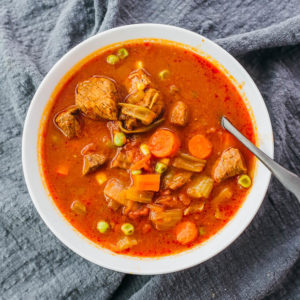
Instant Pot Vegetable Beef Soup
Prep: 30 minutes
Cook: 30 minutes
Natural Release: 25 minutes
Yield: 8 servings
INGREDIENTS
- 2 pounds beef stew meat (Note 1)
- 3 medium ribs celery, chopped (Note 2)
- 3 medium carrots, chopped
- 1 small onion, chopped
- 28-ounce can crushed tomatoes
- 3 cups low sodium beef broth
- 1.25 cups chopped frozen green beans (Note 3)
- 1/2 cup frozen corn
- 1/2 cup frozen green peas
- 1 tablespoon
balsamic vinegar - 1 tablespoon olive oil
- 1/2 teaspoon each: table salt, ground black pepper, ground thyme
INSTRUCTIONS
- Cut Beef: If wet, pat beef dry with paper towels. Cut into bite-sized chunks, smaller than 1 inch. Trim off any excess fat. Season with salt and pepper.
- Brown Beef: Turn on sauté mode on pressure cooker (Note 4) for high heat. Once heated, add olive oil and half of beef chunks, spreading them out. Cook until browned, 3 to 5 minutes per side, then transfer to large plate. Repeat with remaining beef.
- Cook Vegetables: Add celery, carrots, onions, and thyme to now-empty pot. Cook vegetables for about 5 minutes, stirring occasionally. Stir in crushed tomatoes. Turn off sauté mode.
- Add Other Ingredients: Return beef to pot, including any liquid collected on plate. Add green beans and beef broth to pot, stirring in with other ingredients.
- Pressure Cook: Secure and seal lid. Cook at high pressure for 10 minutes, followed by 25 minute natural release. Manually release remaining pressure by gradually turning release knob to venting position.
- Serve: Uncover, and stir in corn, green peas, and balsamic vinegar. Serve and store leftovers (Note 5).
NUTRITION
| Makes 8 Servings |
| Amount Per Serving (1.5 cups): |
| Calories 230 (23% from fat) | |
| Total Fat 6g | 9% |
| Saturated Fat 1g | 7% |
| Cholesterol 75mg | 25% |
| Sodium 740mg | 31% |
| Net Carb 8g | |
| Total Carb 12g | 4% |
| Dietary Fiber 4g | 15% |
| Sugars 6.5g | |
| Protein 29g |
PHOTOS
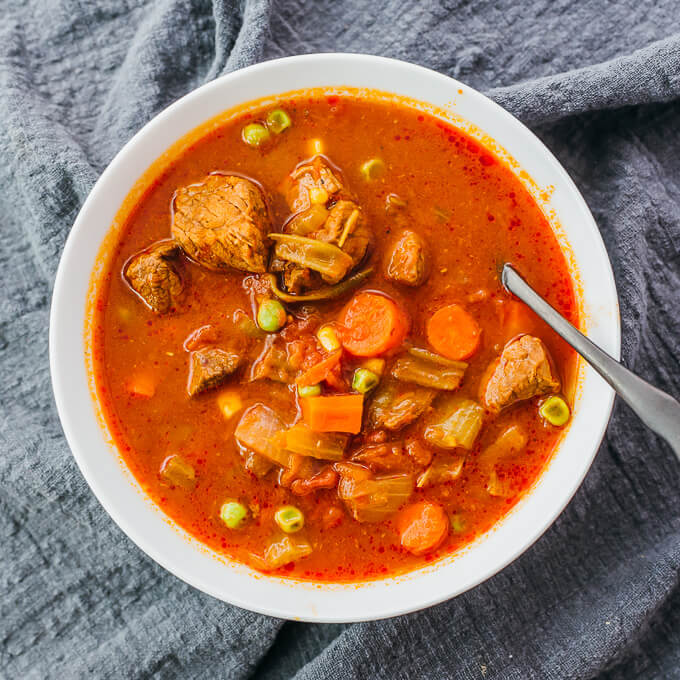
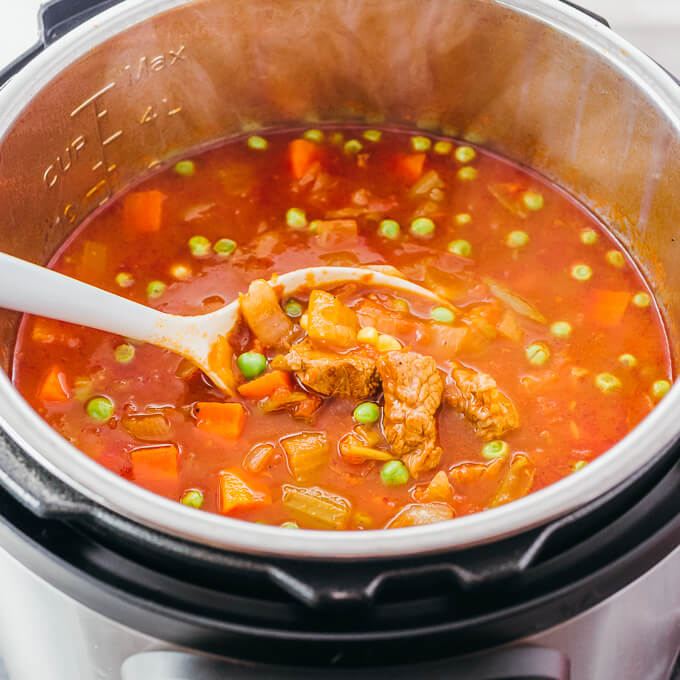
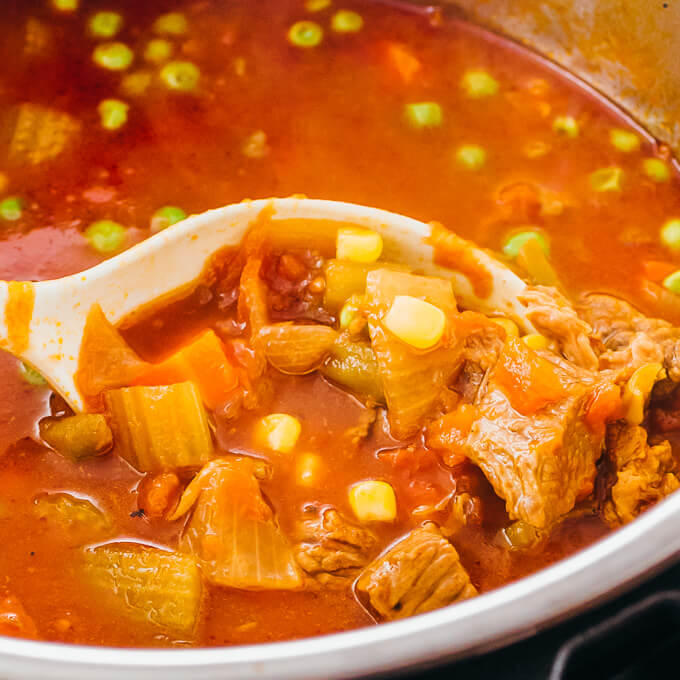
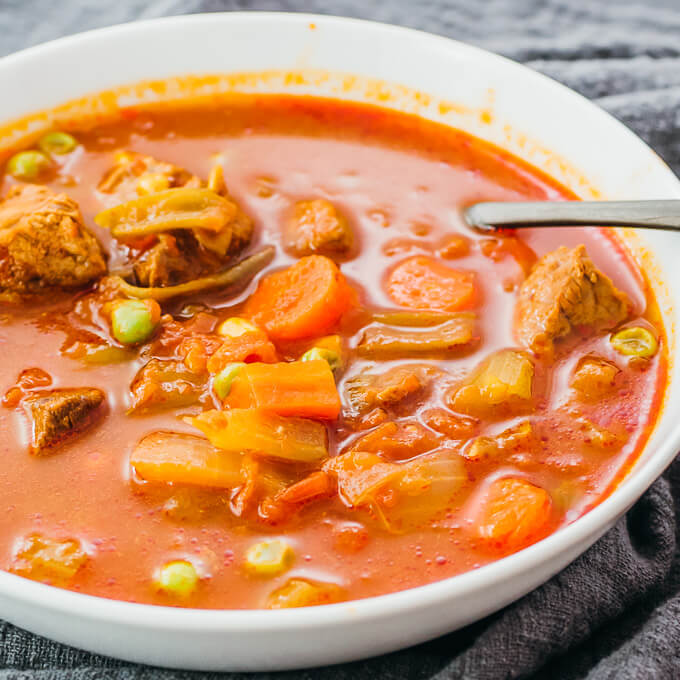



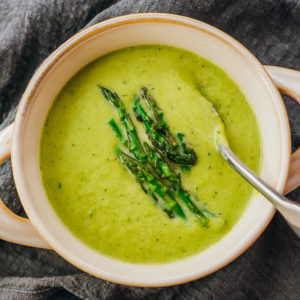
Followed the recipe. Used potatoes instead of string beans -was amazing!
Hi Julia… looks great—cannot wait to try. I have a question for you about this and other recipes that use multiple functions in the Instant Pot… I have noticed on nearly every recipe I try that I have some scorching when I use sautee and then go to the pressure mode. (Manual for whatver the pressure time is, to be more accurate.) I read on another of your recipes that this can hapen when there is not enough liquid in the recipe, but the dish I made this weekend had almost two cups of fluid before I started pressurization and still scorched. I think it is scorching because the element is too hot from the sautee function and the food sits without stirring while it comes to pressure. Any tips for working around this? I am reluctant to work with meat or other expensive items until I figure this out. Thanks for your help!
Hi Lisa! Two suggestions: (1) Turn off the saute setting as soon as you’re done with it, so it doesn’t continue to heat up the food. (2) Just before closing the lid and going into the pressure cooking mode, stir everything around, using a stiff wooden utensil to scrape up any brown bits stuck to the bottom of the pot. Depending on what you’re cooking, some vegetables (like tomatoes) can help you deglaze the pot this way. Or you can add a bit of vinegar or wine to help you loosen those brown bits. Hope that helps!